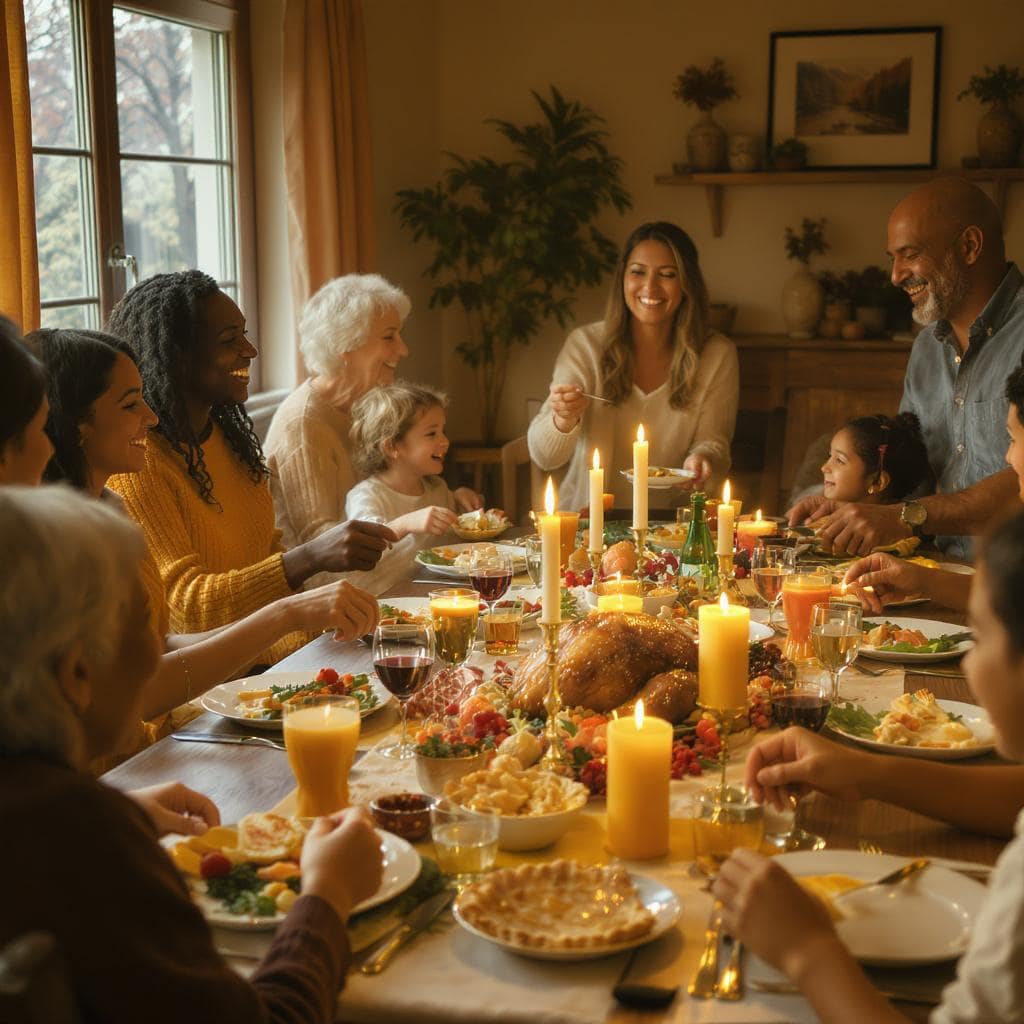Landmines at the Thanksgiving Table: GLP-1s, Food, and Finding Peace Over Pie
Author
glp winnerDate Published
- Twitter
- Facebook
- LinkedIn
- Instagram
- Copy Link

Once upon a time, the biggest Thanksgiving landmine was politics. These days, there’s a new conversational grenade rolling across the mashed potatoes: GLP-1s.
Whether someone’s taking one, thinking about it, or just has opinions shaped by the internet, the holidays have become the season of “So, are you on that shot?”
But beneath the jokes and side-eye servings lies something tender — people trying to manage health, identity, and family expectations in real time. Before the turkey’s carved and someone blurts out “You’ve lost so much weight!” (or worse, “You’re not eating?”), here’s how to make this year’s table a little less explosive — and a lot more kind.
Why This Matters
GLP-1 medications — like semaglutide (Ozempic®, Wegovy®) and tirzepatide (Mounjaro®, Zepbound®) — can change how your body experiences hunger, fullness, and even social eating. They slow digestion, which can make large or rich meals feel heavy.
And while those effects are physical, the emotional side is just as real. Food is tradition, comfort, and connection — and for many, also a source of old wounds or self-consciousness. That’s why approaching these topics with awareness can turn tension into empathy.
1. Should You Talk About Weight or Medication?
Let’s be blunt: it’s almost never helpful to comment on someone’s body at the table. Even “positive” remarks can sting if they highlight something personal.
What “before and after” talk sounds like:
- “Wow, you’re half the person you used to be!”
- “You look so much healthier now — what’s your secret?”
- “I miss the old you before you lost the weight.”
These may sound complimentary, but they frame a person’s worth or identity around appearance. The safer route? Compliment the person, not the pounds.
If you’re on a GLP-1:
You don’t owe anyone details. A calm, friendly line like, “I’m just focusing on what feels good for me right now,” closes the door gracefully.
If you choose to share more, keep it short: “This medication affects my appetite, so I’m pacing myself.” Then steer the conversation somewhere lighter — maybe the parade on TV or your cousin’s suspiciously perfect pumpkin pie.
If you’re not on one:
Avoid curiosity disguised as caring — “You’re not sick, are you?” or “So… how much have you lost?” Instead, focus on connection:
- “It’s so good to see you.”
- “How have you been feeling?”
- “What’s been making you happy lately?”
Weight is data. Kindness is meaning.
2. Food Talk: Handle with Care
Holiday meals are emotional performance art — family history served with gravy. For someone on a GLP-1, it’s a balancing act between physical comfort and social expectation.
GLP-1s slow digestion, so heavy or fast eating can cause nausea or bloating. Foods high in fat and sugar (rich gravies, cream sauces, buttery desserts) tend to hit hardest (Healthline).
If you’re on a GLP-1:
- Don’t skip meals earlier in the day. “Saving up calories” can backfire — you’ll arrive overly hungry, eat too fast, and overwhelm your stomach. Slow digestion means you’ll feel uncomfortably full before your brain catches up.
- Eat slowly. Give your body a chance to register fullness.
- Bring or request one dish that sits well with you — something balanced like lean turkey, roasted veggies, or a lighter side you know you tolerate.
- Be kind to yourself. One festive meal won’t erase progress. It’s okay to enjoy dessert or an extra bite of stuffing. A healthy relationship with food includes flexibility. Enjoyment and self-trust are part of the long-term picture.
If you’re hosting or joining:
- Offer variety — classic favorites plus lighter sides. Don’t label or announce them as “diet” options.
- Avoid pressuring anyone to eat more (“Come on, it’s Thanksgiving!”).
- Emphasize the experience, not the consumption: the smells, stories, laughter, and chaos are the real feast.
3. Meal Planning That Works for Everyone
You don’t have to rewrite your grandmother’s recipes to make the table inclusive. The goal isn’t restriction — it’s balance.
Here’s what that looks like in practice:
- Offer small serving utensils so people can naturally take smaller portions without feeling judged.
- Serve foods family-style instead of pre-plated; it lets everyone choose what works for them.
- Include a few naturally lighter dishes (green beans with olive oil, roasted squash, a salad with vinaigrette). No need to skip the buttery rolls — just make sure there’s choice.
- Hydration matters. Keep water and tea nearby; people on GLP-1s may not feel thirsty but need the fluids for digestion.
A flexible table welcomes everyone, no disclaimers required.
4. Modeling Positive Habits for the Next Generation
Kids (and even adults) learn how to relate to food by watching us. If the holidays become a guilt-fest of “I shouldn’t have eaten that” or “I’ll diet next week,” they pick that up too.
Instead:
- Replace guilt language with neutral ones: “That was delicious” beats “I was bad.”
- Treat mindful eating as normal, not restrictive.
- Add traditions that aren’t food-centric — group walks, storytelling, games, gratitude rituals.
- Celebrate connection, not control.
You’re teaching more than manners; you’re showing that self-care doesn’t mean self-criticism.
5. Mental Prep: Protect Your Peace
Holiday meals are easier when you plan the emotional script, not just the menu.
Anticipate the moments that make you tense. Maybe it’s the uncle who comments on your portion size or the friend who keeps asking about your “miracle shot.”
Have pre-planned replies ready:
- “I appreciate you noticing, but I’m focusing on feeling healthy, not on numbers.”
- “It’s been working well for me — but I’d love to catch up about something more fun.”
- “Everyone’s body is different. Let’s talk about that football game instead.”
Redirecting gracefully takes power away from the question and keeps the vibe light.
And if you’re the one on a GLP-1:
- Be proud of your boundaries.
- Give yourself permission to not be perfect. Enjoy the meal, even if it nudges your calorie goal for the day. Progress isn’t erased by pie.
- Stay hydrated and move a little — a short walk or deep breath does wonders for digestion and nerves.
- If something feels off, let it go. Tomorrow is a new normal.
FAQ
Q: Should I tell people I’m on a GLP-1?
A: Only if you want to. You can keep it simple: “I’m eating differently these days and it’s working for me.” You owe no one details.
Q: What if someone comments on my weight — good or bad?
A: You can redirect:
- “Thanks, I’m focusing more on how I feel than how I look.”
- “I’m still figuring out what balance feels right for me.”
- “I appreciate that — can we talk about the food instead?”
Deflect with kindness, but don’t take on their expectations.
Q: Should I “save up” calories before a big meal?
A: No. That strategy can backfire because GLP-1s slow digestion — arriving famished often leads to discomfort. Eat normally throughout the day so your body stays balanced. (BCM.edu)
Q: Will one big meal undo my progress?
A: Absolutely not. Weight management is about patterns, not perfection. A single high-calorie meal in the context of an overall balanced routine is not harmful. (Drugs.com)
Q: How can I be a considerate host?
A: Offer variety, allow self-serve portions, and skip commentary. Inclusion doesn’t mean changing your recipes — just your tone.
Final Thought
Politics might still divide the table, but empathy can unite it. Whether you’re navigating your own GLP-1 journey or hosting someone who is, compassion is the best seasoning.
Enjoy your meal. Enjoy your people. The goal isn’t control — it’s connection.
If you enjoy posts like these, you can subscribe to receive newsletter updates.
Sources
Keep Reading

Learn what’s changing in 2026 insurance plans for GLP-1 drugs and how to compare costs, coverage, and plan options to stay protected.

Missed your GLP-1 dose? Learn what happens in your body, how to safely make up or skip a dose, and why it’s important to talk to your provider.

GLP-1 medications can jump-start weight loss, but lasting success comes from pairing them with simple, steady habits in food, movement, and recovery.
